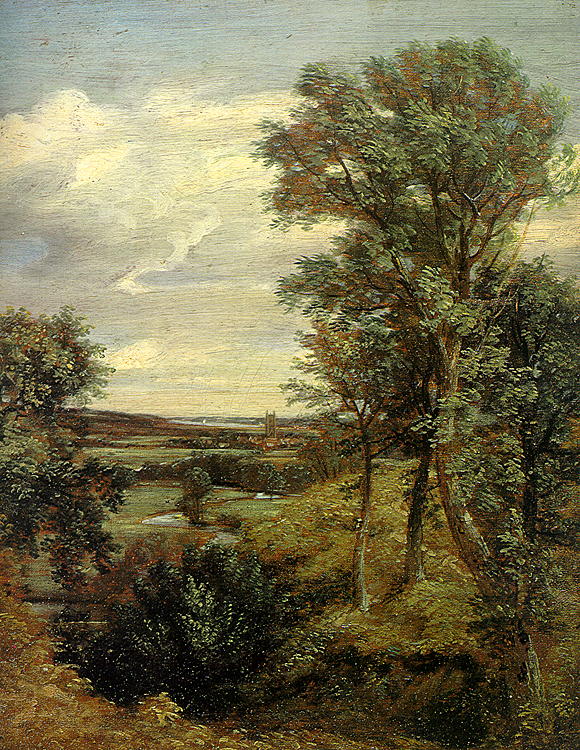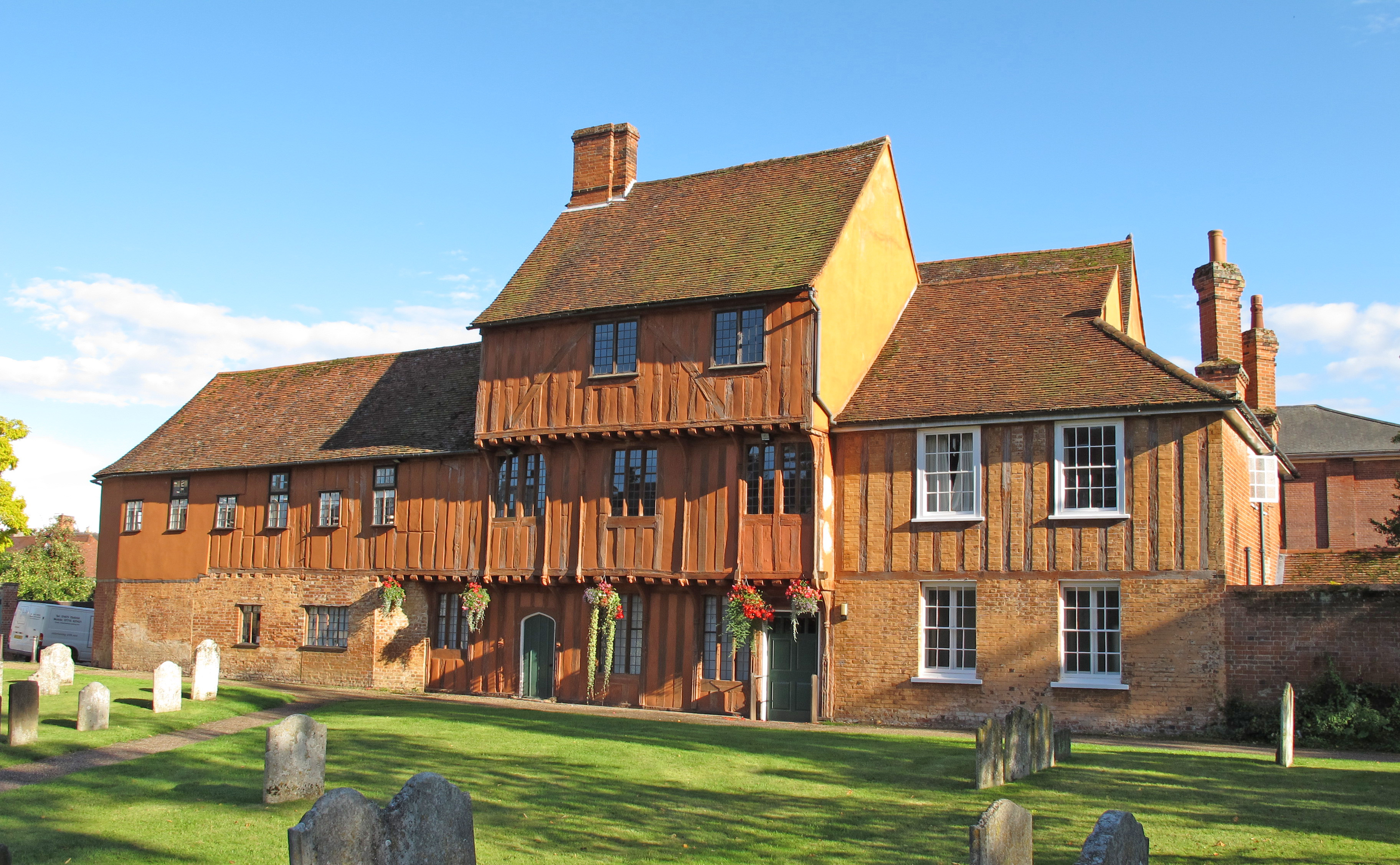|
Dedham, Essex
Dedham is a village in the City of Colchester district of Essex, England. It is near the River Stour, which is the border of Essex and Suffolk. The nearest town to Dedham is the small market town of Manningtree. Governance Dedham is part of the electoral ward called Dedham and Langham. The population of this ward at the 2011 Census was 2,943. Geography Dedham is frequently rated as containing some of England's most beautiful Lowland landscape, most particularly the water meadows of the River Stour, which passes along the northern boundary of the village forming the boundary between Essex and Suffolk. Dedham has a central nuclear settlement around the Church and the junction of Mill Lane and the High Street (part of the B1029). Connected to Dedham are the hamlets of The Heath and Lamb Corner. The village forms a key part of the Dedham Vale. History Early documents record the name as Diddsham, presumably for a family known as Did or Didd. For centuries, the parish of Dedh ... [...More Info...] [...Related Items...] OR: [Wikipedia] [Google] [Baidu] |
City Of Colchester
The City of Colchester is a local government district with city status in Essex, England, named after its main settlement, Colchester. It is, with 194,394 people according to Office of National Statistics estimate for mid 2022, the most populous district in Essex and also includes the towns of West Mersea and Wivenhoe and the surrounding rural areas stretching from Dedham Vale on the Suffolk border in the north to Mersea Island in the Colne Estuary in the south. The district borders Tendring District to the east, Maldon District to the south, Braintree District to the west, and Babergh District in Suffolk to the north. History Colchester was an ancient borough with urban forms of local government from Saxon times. Burgesses were already established by the time of the Domesday survey of 1086. The earliest known borough charter dates from 1189, but that charter appears to confirm pre-existing borough rights rather than being the foundation of a new borough. The borough wa ... [...More Info...] [...Related Items...] OR: [Wikipedia] [Google] [Baidu] |
Colchester
Colchester ( ) is a city in northeastern Essex, England. It is the second-largest settlement in the county, with a population of 130,245 at the 2021 United Kingdom census, 2021 Census. The demonym is ''Colcestrian''. Colchester occupies the site of Camulodunum, the first Colonia (Roman), major city in Roman Britain and its first capital. Colchester therefore claims to be Britain's first city. It has been an important military base since the Roman Empire, Roman era, with Colchester Garrison currently housing the 16th Air Assault Brigade (United Kingdom), 16th Air Assault Brigade. On the River Colne, Essex, River Colne, Colchester is northeast of London. It is connected to London by the A12 road (England), A12 road and the Great Eastern Main Line railway. Colchester is less than from London Stansted Airport and from the port of Harwich. Attractions in and around the city include St Botolph's Priory, Colchester Zoo, and several art galleries. Colchester Castle was constructe ... [...More Info...] [...Related Items...] OR: [Wikipedia] [Google] [Baidu] |
Hadleigh, Suffolk
Hadleigh () is an ancient market town and civil parish in the Babergh district of Suffolk, England. The town is situated next to the River Brett, between the larger towns of Sudbury and Ipswich. It had a population of 8,253 at the 2011 census. The headquarters of Babergh District Council were located in the town until 2017. Origin of the name Skeat, in his 1913 ''The Place-Names of Suffolk'', says this: Spelt ''Hadlega'', R.B.; ''Hadleigh'', Ipm.; ''Hædleage'', in a late chapter, Thorpe, Diplomat, 527; ''Headlega'', Annals of St Neot, quoted in Plummer's ed. of the A.S.Chronicle, ii. 102; ''Hetlega'', D.B., p.184. In D.B. the ''t'' stands for ''th''; and the true A.S. form appears in a Worcs. charter, dated 849, as ''hæðleage''(gen.) with reference to Headley Heath (a tautological name) in Birch, C.S. ii. 40; see Duignan, Placenames of Worcs. The sense is 'heath-lea.' In a similar way the A.S. ð has become t in Hatfield (Herts.) which means 'heath-field'. Histo ... [...More Info...] [...Related Items...] OR: [Wikipedia] [Google] [Baidu] |
East Anglian School Of Painting And Drawing
The East Anglian School of Painting and Drawing was an art learning environment established by Cedric Morris and Arthur Lett-Haines in East Anglia in 1937. It was run on very idiosyncratic lines based upon the ''"free rein"'' approach that was then current in French academies. It had a great influence on many Suffolk artists and made an important contribution to art teaching in the east of England for forty years. Foundation The school was founded by Morris and Lett-Haines on 12 April 1937 in an old house in the centre of Dedham, Essex. In addition to the proprietors, there was a third teacher Ian Brinkworth a secretary, model and one student when it opened. By December 1937 there were 60 students and the school held its first exhibition. The school was described in a prospectus as ''"an oasis of decency for artists outside the system"''. Lett-Haines taught theory, whereas Morris taught by encouragement and example. Lucian Freud was among the earliest students joining at the age ... [...More Info...] [...Related Items...] OR: [Wikipedia] [Google] [Baidu] |
Arthur Lett-Haines
Arthur Lett-Haines (2 November 1894 – 25 February 1978Deaths, ''The Times'', 2 March 1978), known as Lett Haines, was a British painter and sculptor who experimented in many different media, though he generally characterised himself as "an English surrealism, surrealist". He was part of a London artistic circle, which included D. H. Lawrence, the The Sitwells, Sitwells and Wyndham Lewis, but for most of his life lived with the painter and gardener Cedric Morris in Cornwall, Paris and finally Suffolk. Biography Arthur Lett was born 2 November 1894, at 9 Walterton Road, Paddington, London, the son of Charles Lett and Frances Laura Esme Lett (who afterwards married S. Sidney Haines). He was educated at St Paul's School, London and then, planning a career in agriculture, he worked on a farm at Poslingford Hall in Clare, Suffolk. In the First World War he served in the British Army. In 1916 Lett-Haines married (as his second wife; he had been left a widower whilst still a teenager ... [...More Info...] [...Related Items...] OR: [Wikipedia] [Google] [Baidu] |



